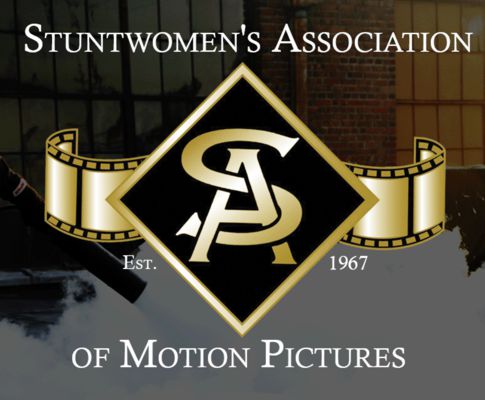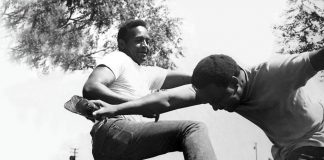Helen Gibson’s strong, handsome face and dark hair gave her the look of someone who would try anything. In 1915, while in her early twenties, she was doubling for the star of the hit serial The Hazards of Helen. In one stunt she was supposed to leap from the roof of the station to the top of a moving train. Years later, she called it her most dangerous stunt. “The distance between the station and the train was accurately measured,” she said, and she had practiced the jump several times while the train was standing still. But for the shot, the train would be picking up speed for about a quarter of a mile. “I was not nervous as it approached and I leaped without hesitation,” she recalled. She landed safely, but the rocking motion of the train rolled her straight toward the end of the car. Just before being pitched off, “I caught hold of an air vent and hung on.” Then, with a sense of the dramatic, Gibson let her body “dangle over the edge to increase the effect on the screen.” She brought the same strength and flair to scores of other action scenes.
Silent movie actresses like Helen Gibson were the first stuntwomen. They were actresses who could ride horses, drive cars, and do high dives. From about 1910 to the early 1920s, they proved that the “weaker sex” could perform surprising physical feats. During that time, the overlapping advent of movies, automobiles, and airplanes, as well as the possibility of women’s suffrage, set in motion a major cultural transformation in America and around the world. Before they worked in movies, many stuntmen had been boxers, carnival performers, cowboys, or soldiers. Their female counterparts were actresses, dancers, and singers, but most of them had no training or experience in physically demanding performance skills. For women who, up to this time, had been restrained by limited opportunities, these brief, innovative, exuberant years must have felt liberating.
Early on, movies became a force for social change because they reflected the concerns and interests of their largely female audiences. Besides love stories, dramas, and action serials, moviegoers watched films promoting the vote for women, such as the popular What 80 Million Women Want (1913). Since 1848, the movement for women’s suffrage had been found, lost, and found again. As many actresses and future movie stars made their first films in 1910, the state of Washington voted for female suffrage, joining Wyoming, Utah, Colorado, and Idaho. Clift called it a watershed year, noting that Washington State “paved the way for California in 1911, Oregon, Arizona and Kansas in 1912.” At the same time, America was on the move, and more and more Americans were taking the wheels of new, affordable automobiles—and that meant women, too. Debate raged about women’s “fitness” to drive, with some trying to connect it to their inability to master the technicalities of the ballot. Despite this, cars gave women mobility and independence and opened up the possibility of radically different lives. All this was encouraged by the action captured on movie screens.
Performing in silent films could be as dangerous as it was glamorous.
The movies were turned out fast, and there were no safety guidelines. Stunts were experiments in action—someone thought up a car crash and had no idea if it would work until someone else actually tried it. The hazards were real. Film historian Kevin Brownlow described it best: “Stunting in the silent days meant walking on tigers’ tails. It was an occupation with few veterans.” For example, in 1916 actress Mary MacLaren appeared in a film for Universal that required her “to drive an automobile backward down an incline at the rate of twenty-five miles an hour, which she did, losing control and going over an embankment.” MacLaren sued the studio and named her mother as a codefendant, seeking “to break a contract that forced her to undertake dangerous stunts while placing her salary under her mother’s control.”
By Mollie Gregory
Continue Reading Full Article at The New Republic


























